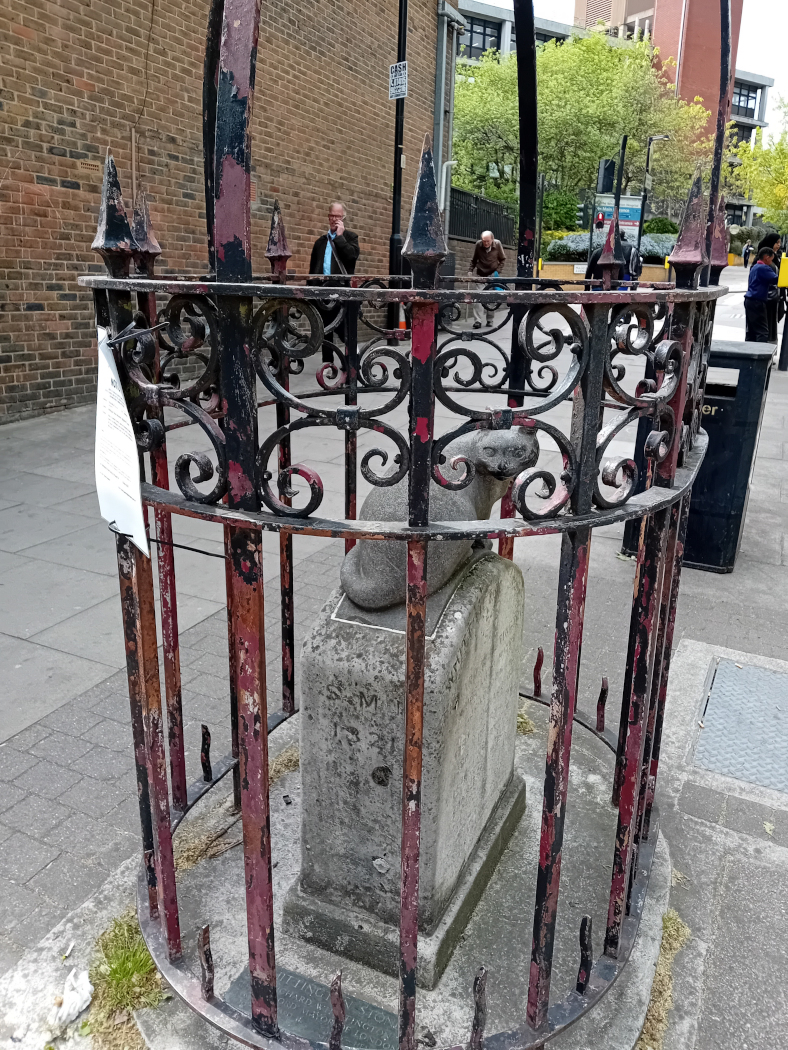

This blue building is London's narrowest multi-story residential building. There is a narrower building on the northern edge of Hyde Park, but it was built to fill a hole and has no residents.
Using Google Maps, you can see for yourself that this building is just as narrow at the back and does not widen towards the rear.


A tree planted by Russian Tsar Peter I during his diplomatic mission to England.



911 memorial in Olympic Park. Made, of course, from pieces of destroyed buildings. The memorial is located on a small hill, which can be reached by stairs. But care for everyone is evident – there is also separate access for wheelchair users at the rear.


In England, a law passed in 1832 stipulates that if sunlight has shone into the windows of an apartment for 20 years, nothing may be built in front of it that would block the light. There are signs on the windows to this effect. There are several such signs in various places; this view is from a café in the churchyard.



One of the oldest statues on a building facade in London.
I took a photo on the spot and started studying it more closely at home. The company whose facade the statue is located on is not a "brothel," as it appears in the photo, but "Sotheby's." 


This is where the man who first described the disease that bears his name lived.



Thomas Becket, Bishop of Canterbury, was born nearby. The bishop came into conflict with King Henry II over church rights. Four of the king's close associates murdered him in Canterbury Cathedral. The king pretended he had nothing to do with it – the boys got a little carried away, let's forgive them. Becket was soon declared a saint.


Next to Liverpool Road station. Children of the Kindertransport.
This was a rescue program between November 1938 and September 1939, in which approximately 10,000 children, mostly of Jewish descent, were evacuated from Germany to Austria, Czechoslovakia, and Great Britain..


It used to be a church (St Mark's Church), but now it has been converted into a restaurant.



The gardening museum is also located in a former church. It's nothing special, but since it's free, you might want to stop by.





A statue of a cat. It was behind such a dense fence that it was difficult to see. But there was a sign saying that it was going to be restored.
Richard Whittington (1354–1423) was a wealthy man and later mayor of London. Legend has it that he got the initial capital for his fortune from selling his cat. We may not believe it, but it's an interesting legend nonetheless.



Point 213 already describes one memorial to the writer Oscar Wilde. But there is another one. About a kilometer southwest along King's Road, next to house number 250. A very strange object. The statue is probably located here because the writer lived only half a kilometer away and was taken to prison from that very house.



Hundreds of meters of walkways built at the beginning of the 20th century. There seems to be no other reason for them than that they are simply beautiful... You can see that some repairs are being done, but it leaves a relatively shabby impression. But once upon a time, ladies in wide snow-white dresses walked here...


A strange object called Cornerstone. Some kind of primitive handicraft, perhaps?




The bell that was rung in the morning to inform the condemned that their last day had arrived. Unfortunately, this is a copy, not the original. It is located in the Church of the Holy Sepulchre.


The shop Charles Dickens wrote about. Dating back to 1567. Good advertising, of course. By the way, if you look closely, there is a trace of an earlier adjoining building on the wall of the house on the left. Does this hint at the relatively later construction date of this shop?
Upon closer inspection, it turns out that this shop was built in 1963. But of course, it's good for business when Dickens himself has advertised for you.  And it's still worth taking a look at this little shop
And it's still worth taking a look at this little shop


One of the platforms at Gloucester Road station (pronounced: gloster!) is not used by trains and hosts art exhibitions. I can't guarantee that you'll see the same things there, but there's definitely something there.




There is a strange text on the wall in the corridor of Farringdon underground station. It looks like the English alphabet in mirror image. But if you look more closely, there is an irregularity in this "alphabet" which, when read together, spells JOHNSTON. This is reminiscent of the font used throughout the underground. Johnston (or Johnston Sans) is a font designed by Edward Johnston. It has been in use since 1913. If you don't recognize it everywhere, take note: the dots above the letters "i" and "j" are small diamonds. This font has been slightly modified over time. In 1979, Japanese designer Eiichi Kono made minor changes to the proportions. In 2016, the font was modified again to make it suitable for digital display, and new symbols were added. It is now called Johnston100.



Morden Underground station. The building is quite nondescript in appearance. Nothing special. The name is somewhat dull. But it is London's southernmost Underground station. And, absurdly, it is located on the Northern line. A prime example of how initial plans and reality do not always coincide when building something.


Tate Modern, a museum of modern art built from a former power station. The exterior is incredibly interesting. The interior... Not so much.




A pedestrian tunnel over 400 meters long. It connects the Underground station to three different museums, and you only have to walk ten to fifteen meters in the rain.
